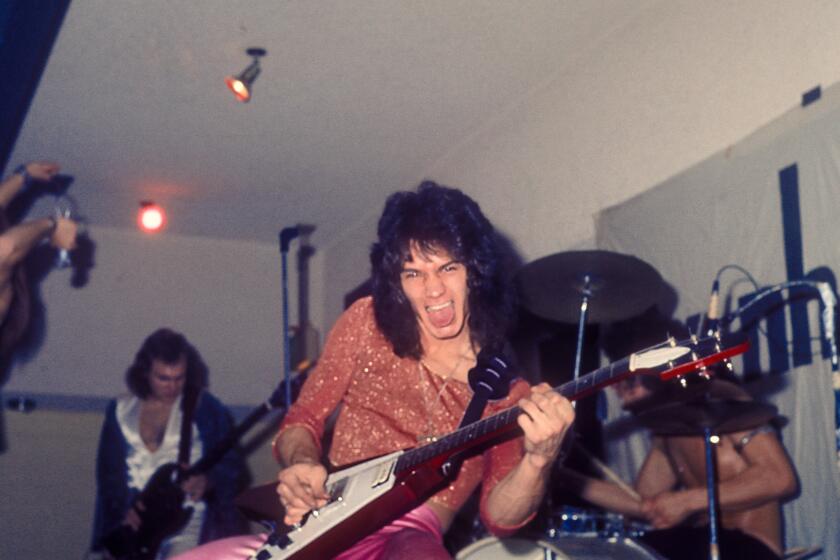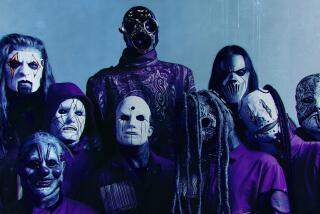Bob Biggs, founder of iconic L.A. independent label Slash Records, dies at 74
- Share via
Bob Biggs, a larger-than-life Los Angeles entrepreneur and painter who harnessed the energy of the Los Angeles punk scene to create the essential independent label Slash Records, died on Saturday, due to complications from Lewy body dementia. He was 74.
His death was confirmed by his wife, Kim Champagne Biggs.
Founded in 1978 as an extension of a successful punk magazine, Slash delivered to the national stage bands including X, Los Lobos, Germs, the Blasters, Misfits, Violent Femmes, Faith No More, L7 and dozens more.
Hardly a stereotypical punk himself — he preferred a nice pair of shorts to bondage jeans — Biggs sensed that what was occurring at Hollywood clubs such as the Masque and the Whisky A Go Go marked the beginning of something special that might resonate beyond Southern California.
Singer-songwriter-guitarist Omar Apollo is part of a wave of young Spanglish-language artists who have captivated pop fans with their bicultural cool.
“From the beginning, our aim was to take music with specific cultural value and take it to a larger audience,” Biggs told The Times in 1983, after Slash had signed a distribution agreement with Warner Bros. Records. “In a business where huge sums of money are the norm, we started with $1 and parlayed it into a company that’s going to be around for a while. And we did it our own way and continue to do it our way.”

Biggs was born in Los Angeles and raised in Whittier. The son of an inventor, his athletic skills and 6-foot-5 frame earned him a football scholarship to UCLA. After an injury sidelined him, Biggs majored in fine art and focused on the L.A. art and theater scenes. He was leasing near the Fairfax district when a couple of young publishers, Steve Samiof and Melanie Nissen, who ran a punk zine called Slash, moved in next door. Biggs became attuned to the culture they were documenting.
“The first memory I have of Bob Biggs was, he was trying to take a cow down the stairs of the Masque,” recalls John Doe, co-founder of X. (Biggs was helping a poet with a pending performance involving livestock.)
“I thought, ‘This Bob Biggs character is awesome.’ He had a great East Coast, almost preppy style that said, ‘I’m a winner. I’m a tall, handsome, white guy and I can get s— done.’ But he was up for crazy ideas, Slash Records being the biggest, craziest idea that he had.”
When Biggs took over ownership of Slash magazine, the zine had seen better days. Biggs recalled to Brendan Mullen and Marc Spitz in “We Got the Neutron Bomb: The Untold Story of L.A. Punk” that after Samiof departed in 1978, “... I was stuck with the magazine, which was not making a lot of money, so I decided to do a record label.”
The first release was a three-song 7-inch called “Lexicon Devil” by the Germs, a quartet of Hollywood punks led by a dangerous-looking dude named Darby Crash. Germs and Slash followed it with “G.I.,” considered one of the great West Coast punk albums of the 1970s.
Though the Germs did well regionally — Crash overdosed a few years later — X’s “Los Angeles,” released in April 1980, was Slash’s breakout. Produced by the Doors’ Ray Manzarek, the album became a regional hit on release, but across the rest of the year sales expanded and grew.
“Even before our album came out, we received letters from people all over,” X’s Exene Cervenka told The Times in a 1981 feature on the label. “They’d either read about us in Slash, or else someone had read Slash and then wrote about us in their own paper.”
For the cover of “Los Angeles,” Biggs turned to his skills as an artist to create the memorable image. “Bob had built an eight- or 10-foot X out of plywood,” Doe recalls, “took it out to the desert, covered it in rubber cement because it burned slower and burned it and filmed it.” Biggs pulled a frame from the film to make the image.
Around that time, the young filmmaker Penelope Spheeris was working on a documentary that shined a light on the bunch of punks rewriting Hollywood’s rules. Called “The Decline of Western Civilization,” Spheeris’ film followed acts including Black Flag, Fear, Germs, X, Alice Bag and Circle Jerks as they gigged around Los Angeles. Biggs is featured in the film discussing Slash. (Biggs and Spheeris were married for a period in the 1980s.)

Across the next decade, Biggs and a small team of less than a dozen built a mini-empire on Beverly Boulevard. Slash released acclaimed records by the Dream Syndicate, the Blasters and Fear. The imprint’s biggest hit of the early 1980s came via Milwaukee’s Violent Femmes, whose self-titled debut album generated underground radio hits including “Blister in the Sun.”
A few years later, in 1984, Slash released the L.A. band Los Lobos’ first album. Called “How Will the Wolf Survive?” it became one of the most acclaimed albums of the year, turning a self-described “just another band from East L.A.” into international stars.
Slash was one of a number of independent rock labels that helped build a nationwide circuit for punk and post-punk artists across the 1980s. Along with I.R.S. Records (R.E.M., the Police), Twin/Tone (The Replacements, Soul Asylum) and SST (Black Flag, Hüsker Dü), Slash served as an on-the-streets arbiter of the California underground rock sound of the time.
Bill Bentley, a longtime Warner Bros. publicist who oversaw Slash’s PR department in the mid-1980s, said that Biggs once outlined his strategy for picking talent: “He said, ‘I look at scenes and I can tell who in that scene has all the excitement around them, and that’s who you sign.’ He learned that in the art world. Certain painters would just get hot. You couldn’t explain it so much by their paintings, but how things converge around greatness.”
He added: “Some record people just have the touch, like Seymour Stein or Lenny Waronker. It’s almost unexplainable how they really decide on something, but they feel it. Biggs really had that.”
Eddie Van Halen, son of blue-collar immigrants, went to Pasadena High. David Lee Roth, his dad a doctor, attended Muir. Their meeting remade rock.
Waronker, whose storied career at Warner Bros. includes overseeing A&R, agreed with that assessment. He said Sunday that he first met Biggs in the early 1980s after he heard the Blasters’ “I’m Shakin’.” “I liked him immediately. He was doing something I couldn’t do, and he was totally open.” That attitude prompted Warner Bros. to team with Slash for a manufacturing and distribution deal in 1982.
“He had a vibe. He walked into the room and things got different,” Waronker continued. “He had a looseness about him, which was really attractive in a business where people are so uptight.” Biggs eventually sold Slash to London Records, but stayed on to oversee operations. That relationship spawned Slash’s most commercially successful release, Faith No More’s “The Real Thing” in 1989.

When Anna Statman, who as head of A&R signed Faith No More, joined Slash, she was employee No. 3. Then a young punk who was working at Licorice Pizza and hanging at the Masque, she helped sort through demos in the mailroom, but soon learned that the office ran with a kind of communal drive. Hardly a taskmaster, Biggs expected excellence but understood, and often participated in, the lifestyle that comes with club life.
Statman described him as “a provocateur. He liked to stir the pot. Bob motivated this small, ragtag group of people to go hard and make a change. To me it felt a little bit like a gang.”
That gang was led by a man who wasn’t much of a music fan, all things considered. His attention was more aimed at cultural disruption, whether through country-rock albums by the Blasters, Rank and File, BoDeans or Del Fuegos, reggae band Burning Spear or New Zealand guitar-pop band the Chills.
“I’ve never felt that the label stood for a specific set of ideals I was obliged to uphold,” Biggs told The Times. “It might stand for honesty of expression and artists who are concerned with integrity in their own work, but the label itself is not about those things.”

Biggs married Kim Champagne, who had served as an art director at Warner Bros., in 1994. They relocated to New York when he became an executive for London Records. After returning to Southern California in the early 2000s, Biggs and Champagne moved outside of Bakersfield to Tehachapi. A few years ago Biggs was diagnosed with Lewy body dementia, a debilitating neurological disease that causes problems with movement, cognition, mood and behavior. In addition to Champagne, Biggs is survived by their son Monty, and a sister, Judy Biggs, of Centerton, Arkansas.
“How do you measure success? By selling millions of records,” Biggs wondered aloud on artist accomplishment to The Times in 1987, “or by changing lives? I’d rather sell only 100,000 copies of an album and be of some cultural value.”
More to Read
Updates
8:54 a.m. Oct. 19, 2020: Updated to include further information on Bob Biggs’ family.
The biggest entertainment stories
Get our big stories about Hollywood, film, television, music, arts, culture and more right in your inbox as soon as they publish.
You may occasionally receive promotional content from the Los Angeles Times.












